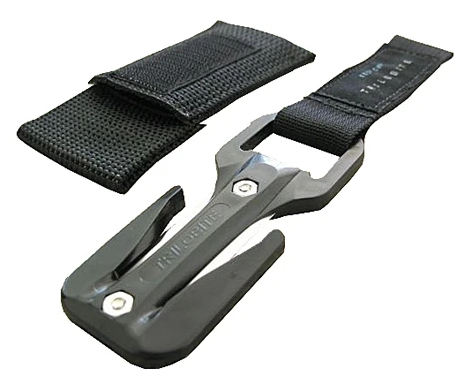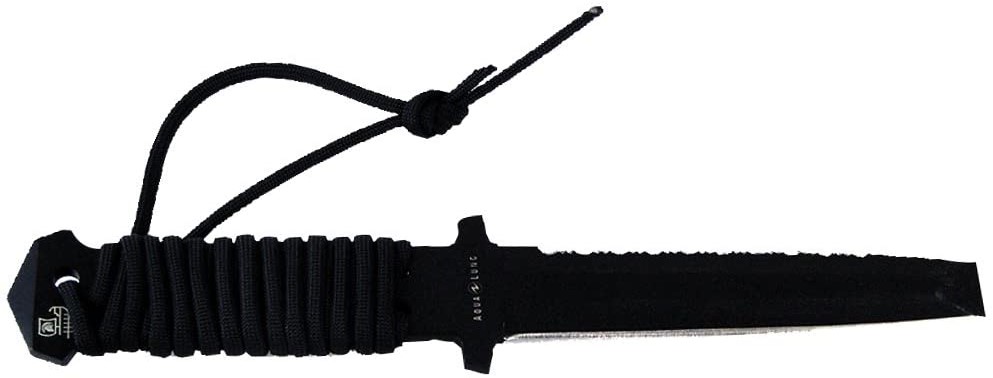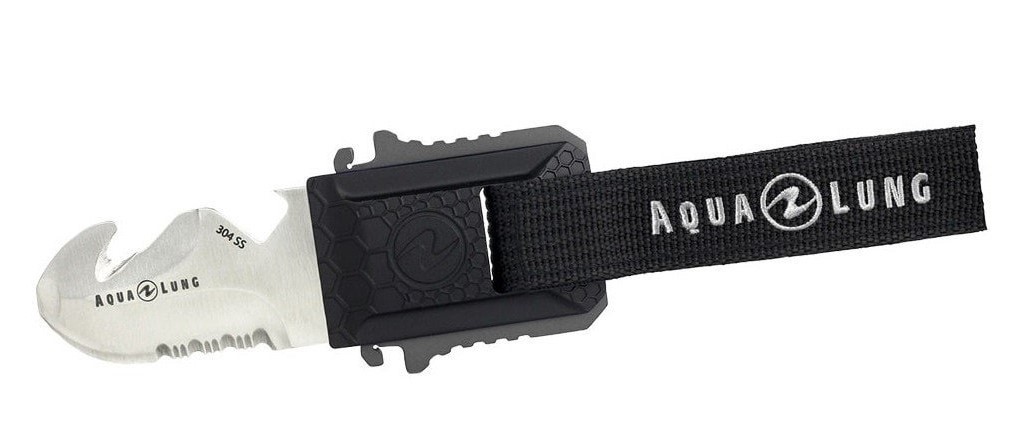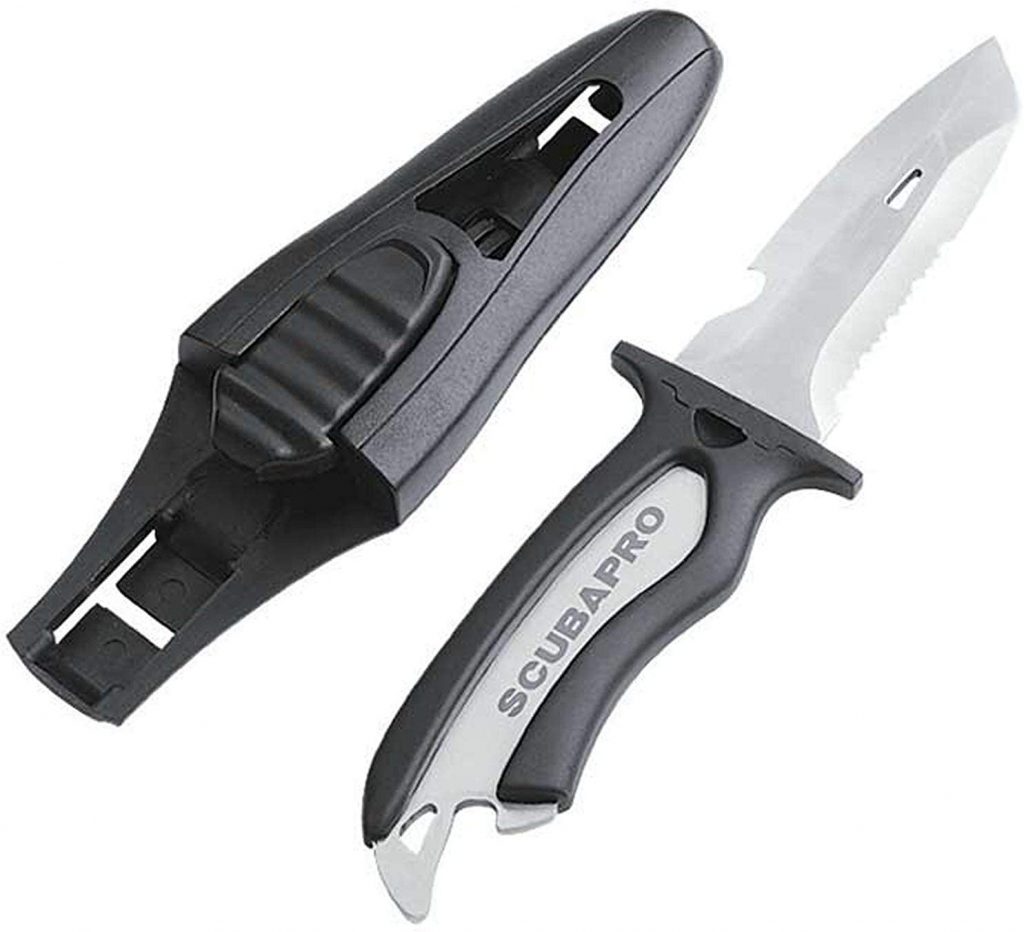Wading out of the water, with Cousteau’s Aqua-Lung hoses slung over either shoulder; the oval mask atop the forehead; and – most importantly – the large, glistening sword-like blade fastened to the lower-leg: this is the quintessential image of ‘the scuba diver’. Clearly, from an image point of view alone, a good dive knife is a key part of being a diver. However, a diving knife has a much greater function than merely enhancing one’s look; it is a life-saving device that every diver should be armed with.
When choosing a dive knife, the type of metal, the blade length, the tip, and the cutting edge(s) must be considered. Secondary to this, though no less important, the placement of the knife, the sheath and additional accessories should be considered. Unlike with other pieces of dive equipment, such as exposure suits or BCDs, the type of dive knife largely does not vary with the type of diver and/or diving; the qualities desired in a knife by the green open-water diver are almost identical to that desired by the advanced technical cave diver. Hopefully, by reading our buyers guide and product reviews, the process of selecting the best dive knife will be simplified.
Best Dive Knives Reviewed
#1 – EezyCut Trilobite Line Cutter

The EezyCut Trilobite Line Cutter is a favourite of many divers of all levels of experience and qualification. Its small size and protected blades makes for easy and safe operation. It also comes with spare replacement blades. Despite being a line cutter, the EezyCut can also make quick work of harness webbing, allowing the diver to quickly cut their buddy out of their harness in a matter of seconds in a rescue scenario. It can be mounted either on the wrist, harness, or it can be stored in an accessory pouch or pocket if so desired. The sheath is a tension sheath with a simple velcro flap, making for very easy drawing and replacement. The EezyCut, however, is only a line cutter, and so you will also need to purchase a separate knife with a serrated edge in order to cover all bases.
#2 – Aqua Lung Argonaut Dive Knife

The Aqualung Argonaut is a top of the range, corrosion-resistant, heavy duty titanium dive knife. This is the perfect knife for those needing to cut through thick anchor lines and similar materials. It’s slightly longer length offers increased cutting efficiency too. Its blunt tip offers greater safety also. This knife is perfect for the diver who dives in very demanding conditions with a high risk of entanglement. However, this titanium knife does come at a far higher price. Similarly, its larger size will make upper body storage options more difficult, meaning that a leg storage system will probably be utilised instead.
#3 – Aqua Lung Micro Squeeze Diving Knife

The Aqua Lung Micro Squeeze Knife offers a small, travel-friendly knife for the diver. It features a serrated edge and a line cutting notch in the one blade. This is an ideal dive knife for those who are not involved in wreck diving or any sort of extreme diving in which there is a high risk of entanglement. That said, however, the serrated edge is still capable of cutting through thick boat ropes, albeit with increased difficulty due to its small size and consequently reduced cutting efficiency. This is a great knife for those who dive in more benign environments.
#4 – Aqua Lung Small Squeeze Dive Knife

This knife offers the same capabilities as the Micro Squeeze but in a slightly bigger, though still small, size. This is perfect for the majority of divers, and the increased size offers better cutting efficiency, for a very reasonable price. The tip of the knife can be customised based on preference, and the knife comes with a sheath and grommets, making BCD attachment possible on Aqua Lung BCD pockets. It also utilises a squeeze lock sheath system, making for a very reliable sheathing mechanism, and therefore less chance of losing your blade.
#5 – Scubapro Mako Titanium Diving Knife

The Scubapro Mako Titanium dive knife is a knife designed with the considerations of travellers in mind. It is a small, lightweight, titanium knife, molded for easy one-handed operation. The sheath itself is angled in order to minimise contact with the suit. This is an inexpensive knife that perfect for your first knife.
Considerations Before Making a Purchase/ Frequently Asked Questions:
Jobs of a Dive Knife
There are three main jobs of a dive knife:
- Cutting through line
- Cutting through rope
- Cutting through wire and other materials
Each job requires a slightly different tool.
For cutting through line, we require either a line cutter or simply the smooth edge of a blade. In the case of the former, this is usually a small instrument, like a trilobite, in which the blade is located on the inside, and calls for a small pulling motion in order to cut. The pulling motion of a line cutter makes for safer, more controlled operation, compared to the pushing motion used with a normal knife.
For cutting through rope, a blade with a serrated edge is required (unless you have herculean strength, in which case skip the blade part and go straight to using your teeth). But in all seriousness, anyone who has attempted, through their own fault or by circumstance, to cut rope with a smooth-edged blade knows that it’s like trying to light a match in a hurricane.
For cutting through materials other than line or rope, a set of shears will be best. Shears provide an advantage in that they are less dependent on force exerted when cutting. They are also safer to operate than knives and are able to be used with one hand – this is not always the case with knives, as they often require a second hand to tension the material being cut. Shears often have a blunt tip, making them easy to store in a thigh pocket despite their increased size.
So, the consequent question is: what dive knife do I require? A tool able to cut through line and rope will cover almost all scenarios the average diver will encounter. The majority of dive knives on the market combine both a smooth and serrated edge on the same blade. Therefore, it is a good idea to, and also very likely that you will anyway, get a cutting tool that allows you to cut through both line and rope. Regarding shears, the option is largely dependent on the specific environment/type of diving you are involved in. For the avid wreck diver, a pair of shears is a very good idea, due to the multitude of potential materials and debris encountered within a wreck environment. Similarly, for those who dive in areas known for fishing, large kelp forests or any sort of commercial activity (where debris and rubbish may be found), a pair of shears would also be a good idea. Ultimately, it would not hurt for every diver to carry a pair of shears, and would only serve to make their experience safer as well as add a layer of redundancy.
However, is it strictly necessary?… For the majority of divers, probably not.
Metal’s Mettle
The first question in knife selection is that of which metal is the better one. The choice at hand is that between stainless steel or titanium.
Stainless steel knives come in two ‘grades’: Grade 304 Stainless Steel and Marine Grade 316 Stainless Steel. Marine Grade 316 SS is slightly tougher and more corrosion resistant than Grade 304, the latter of which will need to be sharpened on a more regular basis. Marine Grade 316 SS is tougher due to the addition of molybdenum. However, despite this difference, stainless steel of both grades share similar problems. Although steel is tough, especially when combined with molybdenum, it will still corrode and rust over time, especially if not looked after properly. A stainless steel blade requires rinsing after every use, as well as the addition of either a specific blade oil or silicone grease, in order to give the metal a layer of protection.
Titanium blades, on the other hand, are completely resistant to corrosion, are tougher, lighter, and will hold their sharp edge for longer. Ultimately, a titanium blade should last the diver longer than a stainless steel blade, all other things remaining equal. However, titanium comes with the drawback of expense, which, in some cases, can be double that of a cheap stainless steel blade. This tends to make titanium blades less attractive to those who do not believe they will be using their knife frequently and also for those for whom the blade is purely to ramp up the Rambo factor.
Does Size Matter?
While size may play an important role in other avenues of life, this is not so much the case when it comes to dive knives.
In terms of cutting efficiency and ease of operation, the longer the blade is, the more efficient it will be with every stroke. Given this fact, it would be expected that the largest knife possible is desirable for the diver. However, in actuality, large dive knives come with a range of drawbacks.
The primary problem of large dive knives is the issue of storage. Large dive knives are best stored on the lower leg, usually strapped around the calf muscle. Out of all the places to store a dive knife, this is arguably the worst, for reasons discussed later in the article. Briefly speaking, lower leg storage is the most inaccessible place in comparison to the other options available, and also causes the diver to break their trim in order to access it. Another problem of large knives is not the knife itself, but the sheath in which it is stored. Often, though of course not always, the sheath required to hold a large knife utilises a system which requires a lot of effort in order to access the knife. This, of course, increases the difficulty of accessing your knife. On top of this, a sheath that requires a lot of effort to open and to access the knife means that if it is not put back together correctly when stowing, the knife will likely fall out of the sheath when replaced. This is when the large size of your knife will truly be the biggest help – when you are searching for it on the seabed.
Ultimately, you want a knife that is as big as it can be without being so large as requiring lower leg storage. For the majority of divers, a knife is something that will be used only in an emergency situation, most likely to cut oneself out of an entanglement. In almost all cases, a simple line cutter or blade with a good serrated edge will suffice. After this, for professional dive guides and/or instructors, a knife may be used for the cutting of anchor lines in emergency situations, which – from personal experience – is perfectly possible with a medium-sized blade with a serrated edge. There are very few situations in which the diver would require a blade so large that it can only be stored on the lower leg. In wreck diving, especially involving deep penetration, or in any area in which there is a lot of ghost fishing nets and/or debris, there may be more of an argument for carrying such a large blade. However, ultimately, if there was a situation in which the cutting efficiency of a longer blade was truly desperately required, the diver would likely be better off to take a normal saw with them, or perhaps a Hydraulic Underwater Chainsaw with the correct training, if needs be!
Sharpness of the Tip
There is a falsehood perpetuated within the diving community regarding the sharpness of cutting tools relative to experience level. In the same way that primary school children are initially armed with blunt scissors, with the sharpness of their scissors increasing relative to their age, this practice is sometimes applied in diving too. It is often said that new divers should have a blunt-tipped knife to begin with, and, as experience increases, move on to a sharper-tipped blade. This, however, fosters the misconception that with experience comes immunity from accidents.
All divers, of all levels, should dive with blunt-tipped blades, unless the sharpness of a stiletto knife, for example, is crucial for a specific part of the dive. However, the tip of the blade is rarely something used in diving, and it is almost always the edges of the blade which are far more important. You want to be able to draw and replace your knife with one-hand without looking. If doing this in dry-gloves, dexterity will be reduced, thereby making inaccuracy in replacement more likely. Therefore, especially with a BCD or inflator hose mounted knife, it is best to have a blunt-tipped blade in order to reduce the risk of an accidental puncture.
Placement
One of the most important considerations regarding your dive knife is where to store it. The brilliance of your blade is of little importance if you cannot access it when most needed. A dive knife should be placed in a position in which it can be drawn easily by either hand, and the position of the tool itself does not pose a greater risk for getting caught/entangled, e.g. a large protruding sheath on the outer leg, for example. Also, if redundancy is favoured and multiple dive knives are carried, then at least ensure that the dive knives are in separate locations from each other in the case that one cannot be accessed. The main options for storage are lower-leg and upper-leg (inner and outer) storage, pocket storage, accessory pouch storage, waist-mounted, inflator hose mounted, BCD mounted, wrist or forearm mounted.
Lower Leg Storage
Let us first consider lower-leg storage. The traditional affixation of a large, shiny sabre to the lower leg is an equipment preference favoured by many divers. However, it is arguably the least optimal location for the storage of a potentially life-saving tool. A dive knife requires a hand in order to work it; therefore, the further away your dive knife is from your hands, the less accessible it becomes. By strapping your cutting tool to your lower-leg, you are thereby putting it in the least accessible location possible. Similarly, a lower-leg mounted cutting tool cannot be reached simply by extending an arm; you must also contract your legs toward you, thereby breaking your trim. In confined/overhead environments, this poses an issue due to an increased risk of silt-outs and also of not being able to reach your cutting tool due to the environment being too narrow/tight to move around in. Furthermore, the legs are often the limbs most favoured by stray nets and ropes to enmesh, meaning that your lower-leg mounted cutting tool – the very thing to free you from such entanglements – will also be caught up in the entanglement. If however, despite the obvious drawbacks of lower-leg placement, you still feel an atavistic urge to use it, or if you already own and use a large knife with no other placement options available, then at least ensure that it is situated on the inner leg for easier reach/less stretch and for lower risk of issues with protrusion. An even better option regarding leg-placement is to have it strapped to the inner thigh; this is the best location for leg-mounted options.
Waist Belt Mounted
The storing of a cutting tool on the waist belt of a harness is a very common practice among technical divers, and, generally, those who dive in a harness/wing/backplate setup. This is a great option for back-mount divers as it is within easy reach of either hand and does not pose an issue of protrusion (as long as it is worn on the left-side when diving with a long-hose setup). However, for those diving sidemount, the waist mounted option is less than optimal. When diving in sidemount, the frontal area of the diver is less accessible due to the position of the tanks; even more so on multi-stage dives. Similarly, the position of the waist belt D-rings makes the placement of a dive knife much more difficult, and would likely interfere with the moving of the tanks. This is where other mounting options become attractive…
Wrist Mounted
A wrist mounted dive knife provides some benefits, especially to the sidemount diver. Usually strapped next to/underneath the computer, the dive knife is the closest it can be to the hands and is therefore very accessible. It is also streamlined. However, wrist mounting a dive knife comes with the drawback that it can only be accessed by one hand. In emergency situations, this poses a risk as, if the hand required to access the dive knife is unable to reach it, for whatever reason, you are in trouble (unless perhaps you have a second cutting tool situated somewhere else). Therefore, it is best that when using the wrist-mounted option that you also have a second cutting tool in another location, such as in a butt D-ring clipped accessory pouch.
Inflator Hose Mounted
Another popular option is an inflator hose mounted cutting tool. This is a very accessible location which can be reached with both hands. The drawback is, of course, that of an increased risk of accidental hose or BCD puncture. If this method is to be utilised, then it is best done with a blunt-tipped knife or line cutter.
BCD Mounted
Lastly, the more modern option is that of mounting the dive knife somewhere on the BCD. Many companies now sell BCDs with an attachable sheath on the side pocket. This is an easy option, utilised by many divers of all levels, and is very accessible in an emergency situation. It is also always attached, meaning that you are less likely to forget to bring your dive knife with you.
The positioning of your dive knife is a bit of a fine art, and can, as with many things dealing with the specific minutia of a system, seem somewhat inane at times. However, in the interest of continuously refining the safety and efficiency of the diving experience, it is necessary. Ultimately, the best test of placement is testing it in the extreme: will I be able to access my cutting tool with either hand in a cramped space, entangled, in the pitch black, with thick dry-gloves on, while sharing air? If the answer is yes, then the system is optimal. Of course, for the warm water recreational holiday diver, this does seem like a ridiculous and unnecessary amount of consideration for such a small element. And, in one sense, it is. A diver could do 10,000 dives across a lifetime with a large, lower-leg mounted knife without incident. However, for those interested in maximising the efficiency and safety of the equipment system in which they dive with, no matter their level, this should be of interest.
Accessories
There are many additional options to consider when choosing a dive knife.
Sheath
The sheath is an important consideration. Squeeze-lock knives are a great option and are very secure. Similarly, tension sheaths, in which the sheath is molded to hold the dive knife without any extra securities in place, are also a great option, and keep removal and replacement very simple. On the other hand, sheaths with covers, clip buttons, or any sort of complex locking system are best avoided for the issue of reduced accessibility, more difficult operation, and for increased chance of losing the dive knife if not properly locked into place.
Colour
Colour is also an option with dive knives. There is an argument that your dive knife, like your alternate air source, should be brightly coloured in order to facilitate ease of identification for other divers. While I can understand the reasoning behind this argument, in my personal opinion, from experience, I dislike the use of a colour-based system for identification and safety. Firstly, if an adequate pre-dive buddy check and familiarisation is conducted, then I do not believe it is necessary to colourise your equipment for matters of identification. Second of all, I think it has the potential to encourage complacency and result in the skipping of pre-dive checks and buddy familiarisations, as the diver may assume that their equipment system does not require an explanation as it is designed in the first place to be ‘obvious’ to the unfamiliar buddy. However, that is a personal opinion, and I am able to see the other side of the argument. Aside from colourisation for safety reasons, colourisation for purely aesthetic reasons – like with most pieces of equipment – is perfectly fine.
There are also many combinations and folding dive knives on the market. Again, in my personal opinion, I would avoid these for matters of simplicity. ‘Keep It Simple, Stupid,’ is a philosophy I respect for diving. If you want a line cutter, get a line cutter. If you want a pair of shears, then get a pair of shears. But, do not combine your shears with your line cutter with your serrated edge and smooth edge blade too, all in one. You would also be better off to have them separate from each other from the perspective of increasing overall redundancy. There is also the old saying that the jack of all trades is the master of none, and this is how I feel – to a degree – regarding combination tools. However, this is, again, just a personal opinion.